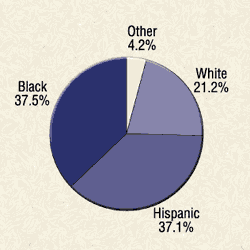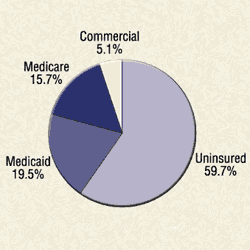Retinal diseases lead causes of blindness among urban patients
These patients were predominantly nonwhite and uninsured.
DALLAS — Retinal diseases, especially retinal vascular occlusions and retinal detachments, were found to be the leading causes of blindness in a predominantly nonwhite and uninsured population, in a study conducted at the Parkland Memorial Hospital here.
“Trauma was a significant cause of severe, unilateral vision loss, especially in the young and in newly presenting subjects. Diabetes was the leading cause of blindness among the 40- to 59-year-old population. Age-related macular degeneration (AMD) played a relatively minor role in the cause of blindness in the study population,” said Preston H. Blomquist, MD. Study results were recently published in Ophthalmology.
Dr. Blomquist and colleagues reviewed the medical records of all 3,562 patients seen at Parkland’s New and General Outpatient Ophthalmology clinic between July 1, 1998 and September 30, 1998 to identify subjects with blind eyes. For the study, blindness was defined as best-corrected visual acuity of 20/200 or less in either eye.
“The records of 397 subjects met the study criteria for blindness and were reviewed in further detail. An etiologic analysis of blindness was performed and classified into 11 categories: retina, trauma, diabetes, glaucoma, lens, cornea, amblyopia, optic nerve, uveitis, tumor and unknown/miscellaneous,” said Dr. Blomquist, an assistant professor of ophthalmology at the University of Texas Southwestern Medical Center.
|
Retina
The retina category included retinal artery and vein occlusions, retinal detachments, infections (such as cytomegalovirus, histoplasmosis and toxoplasmosis), macular pathosis (AMD, holes and scars) and hereditary diseases (retinitis pigmentosa, cone/rod dystrophy and choroidal degeneration).
“Blindness caused by retinal complications of diabetes was considered separately. Blindness in diabetes was secondary to proliferative retinopathy, vitreous hemorrhage or clinically significant macular edema. Glaucoma was sub-classified to include primary open-angle glaucoma, secondary open-angle glaucoma, neovascular glaucoma, normal tension glaucoma and combined mechanism glaucoma. Cataracts and aphakia accounted for lenticular causes of blindness,” Dr. Blomquist said.
The cornea category included abrasions, infections and keratoconus. Optic nerve damage was secondary to anterior ischemic optic neuropathy, optic atrophy or optic neuritis. Causes of uveitis included sarcoidosis, syphilis and fibromyalgia.
Additionally, a demographic analysis of blindness was performed and included age, gender and laterality.
Parkland’s outpatient clinics serve a racially diverse population. During 1998, the outpatient population was 37.5% African American, 37.1% Hispanic, 21.2% white and 4.2% other. Payer status analysis for 1998 showed that 19.5% of outpatient clinic patients had Medicaid coverage, 15.7% had Medicare, 5.1% had commercial insurance and 59.7% were uninsured.
Of the 397 patients who were blind in at least one eye, 214 were women and 183 were men. Their mean age was 55.2 years, and their ages ranged from 8 to 92 years. Also, 321 patients were blind in one eye, while 76 subjects were blind in both eyes.
Leading causes of blindness
Of the 397 blind patients, 50.6% had hypertension, 43.1% had diabetes and 30.7% had both conditions. Retinal diseases were the leading causes of blindness. Ninety patients had retinal pathosis, 71 experienced trauma, 68 had diabetes and 62 had glaucoma. Of the retinal causes, retinal vascular occlusions accounted for 26.7% of visual loss, while retinal detachments accounted for 25.6%.
The most common infectious cause of retinal blindness was cytomegalovirus retinitis. Only five patients had AMD. Also, of the 68 patients who were blind as a result of diabetic ocular disease, sequelae of proliferative diabetic retinopathy were directly responsible for blindness in 58. Of the 62 patients with blindness secondary to glaucoma, 45 had primary open-angle glaucoma.
Dr. Blomquist and colleagues also performed an etiologic analysis of blindness in new subjects — those who had never been examined in the Parkland ophthalmology clinics before the current presentation. Among the 85 new patients, trauma accounted for 28.2% of blindness and was the leading cause.
“The difference in case frequencies of causes between all blind subjects and those newly presenting were not statistically significant except for a decreased incidence in glaucoma in new subjects,” Dr. Blomquist said.
While trauma was a leading cause of unilateral blindness, accounting for 20.9% of cases, it played a relatively minor role in bilateral blindness, accounting for only 5.3%.
“Trauma was twice as prevalent a factor in visual loss in men than in women. Not surprisingly, the prevalence of glaucoma and retinal disorders as a cause of blindness increased with age. Diabetes was the most common cause of blindness among the 40- to 59-year-old age group. Trauma was significantly more common as a cause of blindness in the subject population less than 40 years of age compared with older age groups,” he said.
For Your Information:Reference
- Preston H. Blomquist, MD, can be reached at University of Texas Southwestern Medical Center, 5323 Harry Hines Blvd., Dallas, TX 75390-9057; (214) 648-3837; fax: (214) 648-3815; e-mail: pblomquist@pol.net.
- Apte RS, Scheufele TA, Blomquist PH. Etiology of blindness in an urban community hospital setting. Ophthalmology. 2001;108:693-696.


